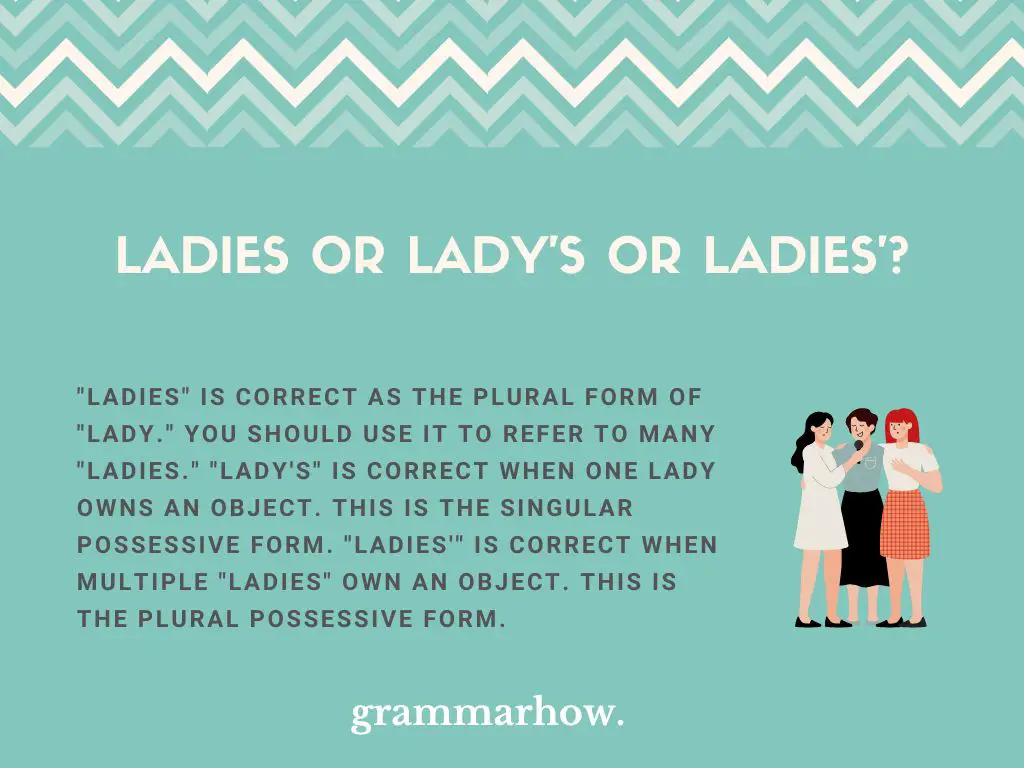Generally speaking, you can use an apostrophe to create a possessive form for most common nouns. Some nouns have different rules associated with singular and plural possessive forms.
This article will explain all you need to know about using “lady” in this way.
Ladies or Lady’s or Ladies’?
“Ladies” is correct as the plural form of “lady.” You should use it to refer to many “Ladies.” “Lady’s” is correct when one lady owns an object. This is the singular possessive form. “Ladies'” is correct when multiple “ladies” own an object. This is the plural possessive form.

You may refer to this to help you understand the different “lady” forms:
| Singular | Lady |
| Plural | Ladies |
| Singular possessive | Lady’s |
| Plural possessive | Ladies’ |
“Lady” follows fairly simple rules when using possessive forms. The only tricky part comes from the plural form, as “lady” ends with a “y.” You must change the “y” to an “-ies” when pluralizing “lady.”
Once you’ve changed “lady” to “ladies,” you can simply add an apostrophe to the end of it. This shows the reader that multiple “ladies” own an object.
And if you only want to show that one “lady” owns an object, you only need to add an “‘s” to the end of the singular form.
Ladies
“Ladies” is not a possessive form, but it is still correct English. You should use it to show that multiple “ladies” are present in your writing.
Every noun ending in “y” follows the “-ies” ending rule. Here are a few more examples:
- Baby and babies
- Butterfly and butterflies
You cannot use “ladies” before an owned object. You must always include an apostrophe to show ownership with regular nouns. Still, “ladies” works well as the plural form.
- There are too many ladies at this event. We’ve got to do something to bring some men in!
- I thought about inviting the ladies, but I was worried you might not want them here!
Lady’s
“Lady’s” is the first iteration of the possessive form. It is the singular possessive form used to show that one lady owns an object. You should use it directly before an object to show what is owned (i.e. “the lady’s gown”).
While the object can come before the possessive form (i.e. “the gown is that lady’s”), it’s less popular to do this.
- The lady’s slipper does not fit. Perhaps this is not the matron I was searching for after all these years.
- What about the lady’s dessert? Don’t you think we owe that much to her?
Ladies’
“Ladies'” is the plural possessive form, showing multiple ladies owning the same object or group of similar objects. It works by adding an apostrophe to the end of “ladies” when it comes before an object.
Unlike the singular possessive form, the owned object should always come after the plural possessive form (i.e. “ladies’ night”). You should not include the owned noun before the plural form.
- Have you considered the ladies’ problems before doing any of this? I don’t want things to go sideways.
- I’m not sure if we have the ladies’ room in our listings for things that need to be fixed.
Conclusion
“Lady” becomes “ladies” when it’s pluralized. Remember, “lady” ends with a “y,” so it becomes an “-ies” to account for this.
From that, you can work out the possessive forms.
“Lady” becomes “lady’s,” and “ladies” becomes “ladies’.” These demonstrate the singular and plural possessive forms, respectively.
